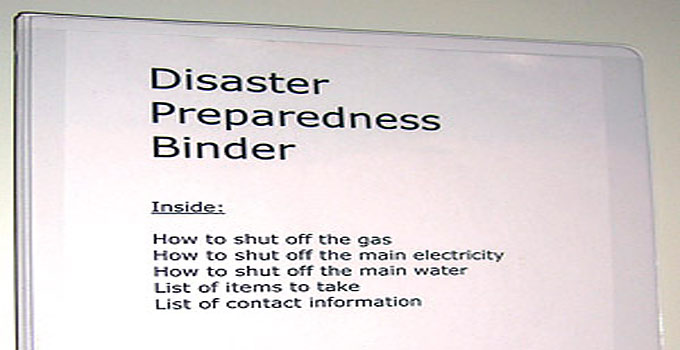Disaster Preparedness Binder

Evacuate! – Are you ready?
The knock comes at your front door. A fireman tells you that you have 20 minutes to evacuate. The wild fire has been burning for several hours now and is headed your way. Panic sets in. What should you take with you? What should you do next?
A disaster preparedness binder will help!
Fires, floods, hurricanes, the list goes on. At a moments notice you may have to leave your home and everything in it that you hold dear. Do you know what you will take with you in the minutes that you have? Are there other things to quickly attend to?
You may be thinking, “Well, I know what to do, I know what to take.” Do you?
What if a degree of panic sets in during an intense time of stress and crisis? Will you be able to think clearly? Remembering everything in the limited amount of time before evacuating your home?
What if you’re not home? What if the only one at home is your spouse, who, lets say, isn’t as into preparedness as you are, or perhaps just your children? Will they know what to do?
Disaster Preparedness Binder
– Instructions, Actions, Information
If you have everything written down, things will go smoother. I prefer the idea of a binder because editing, making changes, and adding pages is easier.
The more detailed you can be in your binder, the better for everyone involved.
For example, Gas Shutoff Valve
If the gas to the house ever needed to be turned off, pictures as well as step by step instructions would be the best. Especially if you are concerned that your spouse or kids may be at home by themselves and have to deal with it. I would insert a picture of the valve itself, along with the proper tool to use. Having the right tool is very important – gas valves are hard to turn. Leave the tool right at the gas meter /valve unit itself so you don’t have to scramble looking for it.
Same detail may be important for Water Shutoff, Electricity, whatever else…
Some information to put in your binder:
How to turn off the gas to your house.
How to turn off the water to your house.
Turn off the electricity.
A list of items to take with you.
A list of contact information including:
– Family and friends
– Insurance companies (home, auto)
– Hotel information (pre-planned evacuation stay)
– Your Doctor info
– Pet vaccinations (some hotels require it)
Smart Phone Side note: Today’s contact information is largely kept in our smart phones. Not too many people have a written record of all this data anymore. In a power down-situation, you will not have access to this information after your batteries have run down. It’s always good to keep hard copies of important documentation in a disaster preparedness binder!
2 Great Ways How to Charge Your Phone When the Power is Out
How to Keep Your Cell Phone Charged During a Power Outage
Pre Determined Hotel Destination
The list of contact information and emergency phone numbers should include a pre-determined hotel destination (keep several destination scenarios). Depending on the evacuation, hotels will book fast! If you have a short list of hotels (with phone numbers) hinged on different perimeters from your own home, life may be easier. Of course heading to family or friends house may be cheaper!
The Best Route To Bug Out Or Get Back Home
A point of contact
Do you have a designated or preferred contact person? In a large scale emergency you may have trouble with communications – especially if the power goes out or it’s a big disaster. On the chance that you are able to get a call through, who would you call first? The idea is to call one person following a major disaster, say a relative living outside of your regional area. This way, other family members or members of your group would know to call that point-of-contact to get updated information or visa-versa.
Evacuation List
An evacuation list – It is imperative to think about and document your list ahead of time. It will help insure that you will take what you consider to be irreplaceable as well as the other things you’ll need for your survival.
Some people keep a ‘bug-out-bag’ at the ready. If you already have a 72-hour kit in your vehicle (which you should), then your short term food and water needs will be met and you can concentrate on any other items that you want to take with you.
Read more: 72-hour Emergency Kit
Take some time and think about it, write it down, and their locations – so you can quickly go get what you need when the time comes.
The point to all this is to write things down in a disaster preparedness binder. This will accomplish several things.
First, it will cause you to think about what you would do in an impending disaster or evacuation. Most people have never even thought about it whatsoever.
Second, having written down the process, you will have ready and detailed instructions assuring that you will not forget anything that you have considered important actions.
Third, A disaster preparedness binder will be different for everyone because it requires your own personal thoughts, requirements, and will vary depending on your regional risk factors and the physical aspect of where you live.
Continue reading: Emergency Documentation To Keep In 72 Hour Kit
Related: Hurricane Preparedness List & Tips
